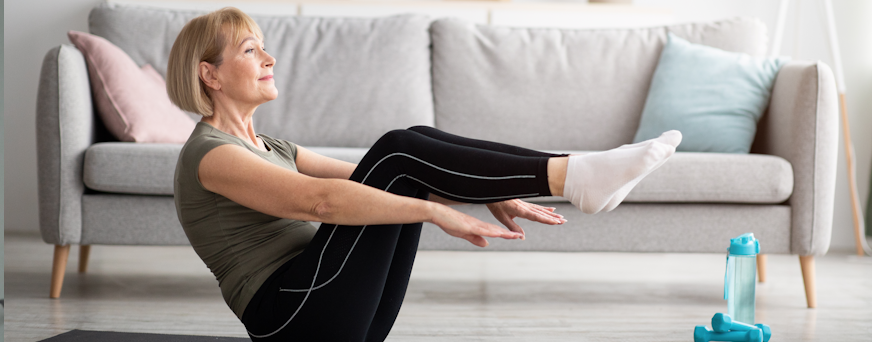Effective Dumbbell Workouts For Seniors: Boost Strength And Flexibility Safely
Staying active is an important part of growing older. Seniors need regular physical activity to maintain health and independence, and dumbbell workouts are a great way to achieve this. Canadian seniors can use dumbbells to improve strength and flexibility, helping them to stay active and healthy. Check out this helpful guide on different dumbbell workouts seniors can try to safely and effectively boost strength, flexibility, and more.
Life Assure Product Quiz
Find The Perfect Medical Alert Device
Take our 30 second quiz and discover which Life Assure medical alert device is the right fit for you or a loved one.
Life Assure Product Quiz
Find The Perfect Medical Alert Device
Take our 30 second quiz and discover which Life Assure medical alert device is the right fit for you or a loved one.
Benefits Of Dumbbell Workouts For Seniors
Dumbbell workouts offer a range of benefits that are particularly valuable for seniors. Strength training with dumbbells helps build muscle and prevent loss of strength, necessary for everyday tasks like lifting groceries or getting up from a chair. Stronger muscles also improve balance and coordination, reducing the risk of falls that can be so common for older adults.
Working out with dumbbells can even boost your mental health. Regular exercise is known to enhance mood and cognitive function, providing a natural way to combat depression and anxiety. Better sleep often follows an active lifestyle, further contributing to a senior's overall well-being.
Flexibility is another area where dumbbell exercises shine. By targeting different muscle groups, seniors can increase their range of motion, making daily activities easier and reducing joint stiffness and pain.
Safety Considerations For Senior Workouts
Before diving into any new exercise routine, seniors should check in with their healthcare providers to establish if it's right for them. This ensures that the chosen exercises align with their health needs and fitness levels. Even low-intensity exercises can pose risks depending on someone's physical condition, so it's important to keep safety in mind to avoid injury. Getting fit won't mean much if you hurt yourself while doing it.
Starting with lighter dumbbells is wise, gradually increasing the weight as confidence and strength build. Proper form greatly helps to prevent injuries, and working with a trainer initially can be beneficial for mastering techniques.
Warming up before and cooling down after workouts are essential to keeping your body safe while you exercise. Warm-ups prepare muscles and joints, reducing the risk of strains, while cooling down helps the body transition back to rest, preventing stiffness.
Best Dumbbell Workouts For Seniors
It's truly impressive how many exercises someone can do with just a dumbbell. Many of these workout routines are excellent for helping seniors build up their physical ability, but where should you start? Here are some effective dumbbell exercises that seniors can safely perform at home or in a gym with little risk of injury:
1. Seated Dumbbell Shoulder Press
Sit on a sturdy chair with feet flat on the ground. Hold a dumbbell in each hand at shoulder height, palms forward. Press the weights upward until arms are fully extended, then lower them slowly. This exercise is great for strengthening shoulders and upper arms, aiding in daily tasks like reaching things high up and lifting from the ground.
2. Dumbbell Bicep Curl
Stand or sit with a dumbbell in each hand, arms at your sides and palms forward. Keep your elbows close to your body as you curl the weights up to your shoulders, then lower them. This targets the biceps, boosting arm strength and endurance that's useful for activities like carrying bags.
3. Dumbbell Squat
Stand with feet shoulder-width apart, holding a dumbbell in each hand at your sides. Lower into a squat by bending knees and hips, keeping your back straight and chest lifted. Press through your heels to return to standing. This strengthens legs and enhances stability, both of which are crucial for preventing a loss of balance.
4. Dumbbell Chest Press
Lie on your back on a bench or the floor, holding a dumbbell in each hand with arms extended above your chest. Lower the weights to chest level, then press them back up. This exercise builds chest and arm strength, aiding in pushing movements during tasks like moving furniture or strollers.
5. Dumbbell Row
Lean forward slightly with a dumbbell in each hand, arms extended toward the floor. Pull the weights up to your torso, squeezing your shoulder blades together, then lower them. Rowing strengthens the back and improves posture, which is important for reducing back pain.
Tips For Incorporating Dumbbell Workouts Into Daily Routine
To make dumbbell workouts a regular part of your routine, consider setting specific, achievable goals you can work towards. These might include increasing the number of repetitions or the weight of the dumbbells over time. Having clear objectives can provide direction and motivation.
You should also try to schedule workouts at the same time each day to build a habit. This consistency can make it easier to stick with your exercise plan. If possible, aim for two to three sessions a week, with rest days in between for recovery. This sets a good pace that's not too taxing but will help you see gains that much quicker, as well as helping you to set the pattern.
Staying motivated can sometimes be challenging, so it's helpful to find a workout buddy or join a group class. Exercising with others can provide encouragement and make the experience more enjoyable. Tracking your progress, whether through a journal or an app, can also be a huge help. It lets you easily see improvements and stay motivated.
It may also help to switch things up. Mixing dumbbell workouts with other exercises like walking or yoga creates a well-rounded fitness routine. This variety keeps workouts engaging and targets different aspects of health, such as cardiovascular fitness and flexibility.
Above all else, remember to listen to your body. If you experience discomfort or fatigue, it's important to rest and recover. Adjust the intensity of your workouts as needed to maintain a safe and effective fitness routine. If you ever feel like you might have hurt yourself or are experiencing consistent discomfort, you may need to consult your doctor.
Conclusion
Incorporating dumbbell workouts into a senior's exercise routine offers numerous benefits, from improved strength and flexibility to enhanced mental health and independence. Starting slowly and gradually increasing intensity is the most important part of a sustainable exercise regimen. An active lifestyle significantly enhances overall well-being and quality of life, so don't wait to get started.











 Get Help With The Push Of A Button
Get Help With The Push Of A Button














